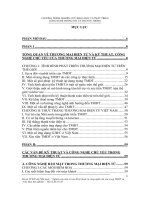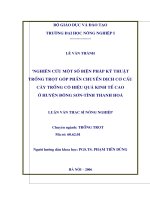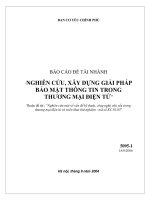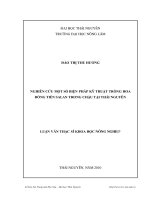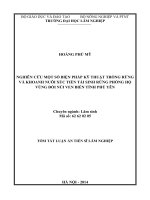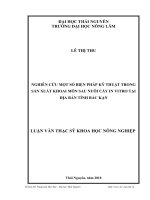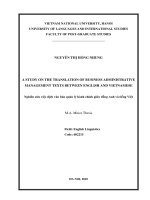Nghiên cứu cách dịch văn bản kỹ thuật trong ngành đóng tàu
Bạn đang xem bản rút gọn của tài liệu. Xem và tải ngay bản đầy đủ của tài liệu tại đây (407.98 KB, 42 trang )
PART I: INTRODUCTION
1. Rationale
Shipbuilding is one of the key industries of our country. The next following years may
see the development in building many kinds of vessels: bulk carriers, oil tankers, container
vessel, car carriers, floating storage and offloading units …. Each kind of vessel has it own
technical specification. And in order to understand the structure, technical characteristic as
well as the operation, the translation of these technical documents has become more
importantly than ever before.
As a translator in a shipbuilding company, the author of this minor thesis days by days
work with technical documents. She is fully aware that the translation of technical document is
a difficult job, it requires the translator to continuously improve basic knowledge on
shipbuilding as well as skill in dealing with situations relating to technical terms, special
expressions, and ambiguous structures…
That is the reason why the author chooses the study on translation of technical texts in
shipbuilding for her MA minor thesis with the hope that the study can provide the translator a
general view on translation of technical texts in shipbuilding industry and the author herself
can improve her job.
2. Aims of the study
The study is implemented with the following aims:
o To clarify some aspects in translation of technical texts in shipbuilding
o To delve into some problems relating to translation of technical texts in shipbuilding
o To put forward some suggestions for solution of difficulty in translation
3. Scope of the study
Technical translation is a huge field, each technical field has it owns characteristic,
therefore, the translator working on any field of technical translation has to try her/ his best to
1
fulfill her/ his job. The translation of technical texts in shipbuilding is not an exception. Within
the scope of this study, a study on the translation of technical texts in shipbuilding is very
exclusive to talk about. However, due to the limitation of time and lack of experience, my
minor thesis is only limited to dealing with some aspects, problems in translating technical
text in shipbuilding.
4. Method of the study
To set up the framework for this study, the author refers to some in-house and foreign
publications. In order to achieve the goal of the study, the main method is quantitative data
analysis. All the considerations, conclusions in this minor thesis are largely based on:
o Reference to relevant publications
o Analysis of collected data
o Personal observations
5. Design of the study
The study consists of three parts:
Part 1, introduction, includes: rationale, aims, scope, method and design of the study.
Part 2 is the development, the focus of the study with three chapters: Chapter 1 is general
theoretical background, it introduces general information about translation theory. Chapter 2
deals with an investigation into translation of technical text in shipbuilding. In this chapter,
some kinds of technical shipbuilding texts, aspects and problems related to translation these
documents are analyzed. Chapter 3 is the implication. This chapter points out some mistakes
the translator often meets in translating and some suggested solutions. Part 3 is the conclusion.
2
PART II: DEVELOPMENT
Chapter 1: Theoretical background
1. What is translation?
Translation has been the subject of interest not only to linguists, professional and
amateur translators, language teachers but also to other engineers of other technical fields. A
great number of publications have been written about this matter. However, “What is
translation?” is still a question in need of research Barkhudarov (1975) defined translation as
“the transformation of a speech product in one language into that of other language keeping
the content (or meaning) unchanged”, by speech product he meant translation as an act of
communication. Catford (1965) considers translation is an cognitive behavior by saying that
“Translation is the replacement if textual material in one language (source language) by
equivalent textual material in other language (target language)”. For Nida & Taber (1974),
translation “consists in reproducing in the receptor language the closet natural equivalent of
the source language message, first in terms of meaning and secondly in terms of style”. Hatim
& Mason (1990) termed it briefly “Translating is a communicative process which takes place
within a social context”.
Different scholars defines translation in different way, seemingly, they have not come up
with a “single valid comprehensive theory of translation”, that is because they seem to look at
translation from different views.
2. Text, discourse and translation
2.1. About text, discourse and translation
Text and discourse sometimes are confused in linguistic. For Windowson, a text is
“sentences in combination”, and discourse is the “use of utterances in combination”. To put it
more clearly, text is a “structured sequence of linguistic expressions forming a unitary whole”
and discourse is a “structured event manifest in linguistic (and other) behavior”. Yet, these
definitions do not satisfy because text and discourse sometimes are used interchangeably, and
text is referred to as “written documents” while discourse as “speech”. Thus, Roger (1991)
3
proposed the following: text is “the formal product of selections of options from the THEME
systems of the grammar; a unit which carries the semantic sense of the proposition (the
propositional content and locutionary force of the speech act) through sentences which are
linked by means of cohesion” and discourse is “ a communicative event which draws on the
meaning potential of the language (and other systems of communication) to carry
communicative value (the illocution force) of speech acts through utterances which are linked
by means of coherence”.
A text is a string of sentences, a unit of language in use. A discourse is a communicative
process by means of interaction and its linguistic product is text. And discourse refers to the
connected speech or writing at supra – sentential levels while text – both written and spoken –
is seen as the representation of discourse.
Discourse analysis is the analysis of language in use and includes in itself the analysis of
the text beyond and above the sentence. Thus, text is one of the core terms in translation.
2.2. Types of text
Type of text is an important factor in translation. It affects on all stages of translation and
translation product. That is the reason why that this matter is always discussed in translation.
According to Newmark (1988), one of the most important function of language is to help
the users to express their feelings, thus equivalent to expressive function of language, we have
expressive text. Imaginative, authoritative statements and autobiography, essays, personal
correspondence are some sub-types of this kind of text.
The very important function of language is informative function. For Newmark (1988),
“the core of the informative function of language is external situation, the facts of a topic,
reality outside language, including reported ideas or theories”. The informative text –type
includes scientific papers, textbooks, popular science or art books, popular journalism.
The third function of language, as Newmark (1988) proposes is to call upon the
readership to act, think or feel in order to react in the way intended by the text, say, vocative
text. This text – type is also called instrumental, operative text aiming at producing a certain
4
effect on the readership. This text type includes: instructions, publicity, propaganda,
persuasive writing.
Besides, Newmark also bases on 3 other functions of language which were proposed by
Jakobson to classify some other text – types: The aesthetic function – aesthetic text, the phatic
function – phatic text, the metalingual function – metalingual text.
2.3. Text analysis in translation
Text analysis plays an important role in translation process, thus, it is always paid
attention by both the translator and the translation researcher. According to Newmark (1988),
analysis of a text is a procedure in which the translator must read the text, find out the
intention of the text, text styles, readership, as well as stylistic scales, attitude, setting. Besides,
the translator has to take into account the quality of the writing, and before translating, he/ she
has to read the text the last time.
2.3.1. Reading the text
The translator, at first, is the reader, but not the normal reader. At least, he is both reader
and reader – translator. As Newmark (1988) claimed, the translator begins the job by reading
for two purposes: “to understand what it is a bout; to analyze it from the translator’s point of
view”. The translator has to define its intention and the way it is written for the purpose of
selecting suitable translation method and identifying particular problems.
Also, Newmark (1988) suggested in order to understand the text, general reading and
close reading are required. General reading is “to get the gist”. The translator can gather
general information about subject of the text through textbooks, specialist papers. Close
reading is to read “words both out of and in the context”.
2.3.2. The intention of the text and the intention of the translator
In reading, the translator, as Newmark (1988) stated, searches for the intention of the
text, he/ she can not isolate this from understanding it. Intention of the text is shown through
the selecting means like grammatical structures, vocabulary of the writer, for example: two
texts describe the same subject as a battle for instance, the positive text uses positive
5
expressions, vocabulary such as hopefully, luckily…. However, the negative text, conversely,
uses negative expressions, vocabulary like unfortunately, it is a pity that…. “The intention of
the text represents the SL writer’s attitude to the subject matter” (Newmark (1988)). Thus, the
first and very important task is to search the intention of the text.
And, also according to Newmark (1988) “usually, the translator’s intention is identical
with the intention of the source text author”. But sometimes, it is adapted by the translator to
make it suitable to new readership.
2.3.3. Text styles
Understanding text styles is an important step in analyzing text. According to Nida
(1979), four types of text are divided as per the text styles. The first is narrative text , it is a
“dynamic sequence of events”, and because it is a sequence of event, it is expressed by a string
a verbal actions. The second type is descriptive. This kind of text is, on the contrary, is “static
with emphasis on linking verbs, adjective, adjectival nouns”. The third type is discussion, it is
“a treatment of ideas, with emphasis on abstract nouns (concepts), verbs of thought, mental
activity, logical argument and connectives”. And the last type as Nida (1979) suggested is
dialogue with “emphasis on colloquialism and phaticisms”.
2.3.4. Readership
The readership is a group of readers that the text is aimed at and this group is marked
with level of education, the class, age and sex. In translation, as Newmark (1988) claimed, the
readership of SL text should be characterized, then the readership of the translation to decide
how much attention to pay to the TL readers.
And, Newmark (1988) states that there is a tendency to make the translation for
“educated, middle – class readership in an informal, colloquial style”
There are three types of readership: expert, educated layman, and the uniformed.
2.3.5. Stylistic scales
To understand and form as suitable text, the translator has to identify the stylistic scales
of the text. For example, basing on the formality, texts can be divided: officialese, official,
6
formal, neutral, informal, colloquial, slang and taboo; basing on the generality and difficulty,
texts can be divided into: simple, popular, neutral, educated, technical and opaquely technical;
and basing on emotional tone: intense, warm, factual and understatement.
2.3.6. Setting of the text
To learn about the setting of the text, Newmark (1988) suggests is to find out the place
where the text will be published in TL, the TL equivalent of the SL periodical, newspaper,
textbook, , the clients and their requirements, also take into account the “briefer title,
absence of sub-titles and sub-headings, shorter paragraphs, and other features of the TL
house-style”.
The translator has to “make several assumptions” about the readership, that is to say,
who they are, their education….
2.3.7. The quality of the writing
Another important thing the translator has to pay attention is the quality of the writing in
order to choose the translation method. The quality of the writing, as Newmark (1988)
claimed, depends upon the author’s writing skill, author’s intention and the requirement of the
subject matter. A text is considered to be a well – written one when is uses the right words in
right places, it has a minimum of redundancy, it is logical, …. The authority of a text is subject
to the status of writer in his field. If the text is written by an experts, of course, the accuracy is
better. If the text is written with “stereotyped phrased, poorly written”, the translator at that
time, has to deal with the badly written text.
2.3.8. The last reading
At last, the translator should read the text, he/ she should underline “all neologism,
metaphors, cultural words and institutional terms, technical terms, proper names, and
“untranslatable” words” to identify the “semantic range, the frontiers”. This can be
considered to be the last analyzing step in translating process.
3. Translation method
7
For a good translator, which could be considered the utmost importance and the
guideline in translation job is translation methodology. It has been a central problems whether
to translate “literally or freely” at least since the first century BC. Many years have gone, some
methods have been identified and Newmark (1988) has put the argument in the form of a
flattened V diagram as the following:
Diagram 1: V diagram of translation method by Newmark (1988)
3.1. Word – for – word translation
Word – for – word translation is a method in which the words are translated “singly by
their most common meanings, out of context”, the method in which the “SL word – order is
preserved”. This method is used to understand the mechanics of source language and to
attempt to analyze preliminarily draft of translation process.
3.2. Literal translation
This kind of method is somehow similar to word – for – word translation in that “the
lexical words are again translated singly” except for one thing, that is, it lays focus on the
conversion of the SL grammatical construction into their nearest TL equivalents.
3.3. Faithful translation
This method reproduces the precise contextual meaning of the original and deals with the
constraints of the TL grammatical structures. Its aim is to be “completely faithful” to the
intentions and the text-realization of the SL writer.
8
3.4. Semantic translation
Semantic translation takes into account the aesthetic value – the beauty of the SL text. It
is more flexible than faithful translation in that it admits creative exception to 100% fidelity
and allows the translator’s intuitive empathy with the original.
3.5. Adaptations
For this type of translation, the SL culture is converted to TL culture and the text is re-
written by the experts in the field of the text content. It is used mainly for plays and poetry. It
is the “freest” form of translation.
3.6. Free translation
Free translation reproduces the manner without paying attention to the manner, it
expresses the content without the form of the original.
3.7. Idiomatic translation
This type of translation conveys the “message” of the original text. And with idiomatic
translation, nuances of meaning are transmitted to TL text by colloquialisms and idioms which
do not have in the original.
3.8. Communicative translation
Communicative translation presents the exact contextual meaning of the original in such
a way that both content and language are made to be acceptable and comprehensible to the
readers of TL language.
On analyzing the method of translation, it is experienced that communicative translation
is appreciated. However, depending on the text type, the translation method is chosen because
with this kind of text, this method is the best but it is not good for the others.
4. Equivalence in translation
Equivalence can be considered as a fundamental conception in translation and it is
mentioned in most of the definitions of translation, however, it is difficult to agree on a
9
uniform concept of equivalence. Thus, there exist many categories of equivalence: content
equivalence, stylistic equivalence, formal equivalence, functional equivalence, textual
equivalence, dynamic equivalence, communicative equivalence, pragmatic equivalence and
equivalence of effect by scholars like Winter (1961), Catford (1965), Nida & Taber (1969),
Will (1977) and Jager (1975).
And according to Newmark (1988), the utmost purpose of any translation is to reach
“equivalence effect”, that is to say, to create the same effect (or one as close as possible) on
the group of readers of translation and the readership of the original.
Within this minor thesis, the writer only considers some equivalence types which are the
most mentioned and are applied widely.
4.1. Quantity based equivalence
- One to one equivalence:
For this kind of equivalence, there is a single expression in TL for a single expression in
SL. This equivalence is commonly seen in terminology.
- One to many equivalence
There are many expressions in TL for a single SL expression in this kind of equivalence.
- One to part one equivalence
With this equivalence, one way of expression in SL has more than one meaning but the
way of expression in TL is only equivalent to one of the meanings.
- Nil – equivalence
There is no equivalence in TL due to difference in culture
4.2. Meaning – based equivalence
This kind of equivalence is considered by Koller (1979) as follows:
- Denotative equivalence
The equivalence in which both SL and TL expressions show the same definition, event
in real life.
- Connotative equivalence
10
This type of equivalence bases on connotation of language. It provides additional values
besides denotation value. This equivalence is formed by selecting words in different aspects
such as style, usage, social, usage frequency…. It can be connotation of poetry language,
connotation of socially determined usage, connotation of geographical relation or origin,
connotation of stylistic effect, connotation basing on evaluation, connotation basing on
attitude and connotation basing on register (the case of technical language).
For the author of this minor thesis, connotative equivalence basing on register is of great
interest and importance because her topic deals with the translation of technical text in
shipbuilding and the equivalence of technical text translation is based on connotative register.
- Text – normative equivalence
For this type of equivalence, the SL and TL expressions are used in the same or similar
context in their respective language like correspondence and law.
- Formal equivalence
The equivalence formed by form expression when both the SL and TL have the same
aesthetic feature which is created by formality. The equivalence is originated from rhyme,
tune, style of poetry, metaphor, …
5. Technical translation
In modern world, science and technology are applied in every aspect of life, thus, the
number of scientific and technological texts appear in a great number. And the profession of
translator is co-extensive with the rise of technology, and staff translators working in that field
are usually called technical translators. But what is technical translation?
Newmark (1988) defines and distinguishes technical translator from institutional
translation “Technical translation is one part of specialized translation; institutional
translation, the area of politics, commerce, finance, government etc., is the other”. He also
suggests that technical translation is potentially non-cultural and universal because the benefits
of technology are not confined to one speech community. In his view, the technical terms
should be translated, whereas, the institutional translation is cultural so the terms are
transferred.
11
Also, according to Newmark (1988), technical translation is primarily distinguished
from other forms of translation by terminology, its characteristics, grammatical features
(passives, nominalizations, third person, empty verbs, present tenses) and it technical format
(technical report).
5.1. Technical style
Newmark (1988) suggests “unless its non-technical language is jazzed up and
popularized, it is usually free from emotive language, connotations, sound-effects and original
metaphor, if it is well-written”. However, not all the technical texts are well – written, thus,
it’s the translator’s job to rephrase poorly written language.
Regarding to technical style, Parpcke (1975) distinguished four kinds of technical
language: scientific, workshop level, every day usage level, and publicity/ sales. Yet,
according to Newmark (1988), the division Parpcke is “likely to be valid only for one or two
terms in a few fields”. He suggests the following scales: academic, professional and popular.
5.2. Technical terms
Newmark (1988) states that “ Technical translation is primarily distinguished from other
forms of translation by terminology”. Thus, the core characteristic of a technical text in any
field is terms; terms are also the main factor to distinguish a technical text from other kinds of
texts. And, the central difficulty in technical translation is usually new terminology.
It is due to the fact that some technical terms appear only once in the source language
and the context is not clear to the translator. Furthermore, the technical terms are distilled
knowledge and written for specialists in that field.
It is also because that even standardized terms may have more than one meaning in one
specific field, as well as in the other fields.
5.3. Technical terms and descriptive terms
One matter in technical translation is to distinguish technical and descriptive terms.
According to Newmark (1988), the original SL writer may use a descriptive terms for a
technical object for three reasons:
12
o The object is new, and has not yet got a name
o The descriptive term is being used as a familiar alternative, to avoid repetition;
o The descriptive term is being used to make a contrast with another one.
Also, he suggests that technical terms and descriptive terms should be translated by their
counterparts, and the translator should resist the temptation of translating a descriptive terms
by a technical terms for the purpose of showing off his/ her knowledge. However, he points
out that if the SL descriptive term is being used either because of the SL writer’s ignorance, or
because the appropriate technical term does not exist in the SL, and if an object strange to the
SL but not to the TL culture is being referred to, the translator is justified in translating a
descriptive term by a technical term.
Further to technical and descriptive terms, Newmark (1988) claims it is a trend that
professional translators make “a mystique out of their craft” by denying any descriptive terms
where a TL technical term exists. He points out the reason that because technical terms are
standardized language and more precise (narrower in semantic range) whereas, descriptive
terms are non-standardized language.
5.4. Translation method
5.4.1. Beginning technical translation
Idiom says that “practice makes perfect”. Technical translation is similar. The more the
translator get practice, the better he/ she translates. However, the challenge or the difficult
thing for the technical translator is that the translator is not well – informed about the topic of
the technical text, is lack of knowledge about technicality. And as Newmark (1988) advises
the translator is “more interested in understanding the description, the function and the effect
of a concept such as entropy rather than in learning laws, particularly axioms, theorems,
theories, systems in some of which entropy is involved”. Or to put it more clearly, “to translate
a text you so not have to be an expert in its technology or its topic; but you have to understand
that text and temporarily know the vocabulary it uses”.
He suggests as a translator working in technical translation, when translating a text, the
translator has to be able to stand back and understand roughly what is happening in the real
13
life or he/ she has to convince himself/ herself that the sentence which has just been translated
makes sense. Although many technical terms can be translated “literally”, the translator has to
check the present validity with the register and dialect.
Thus, in order to begin a technical text, according to him, the translator should, at first,
read it to understand what the text is about (underline difficult words) and then assess its
nature ( proportion of persuasion to information), its degree of formality, its intention (attitude
to topic), the possible cultural and professional differences between the readership and the
original one. Next, the translator should give the translation a framework of recognized house-
style. The translator has to take into account everything, every word, every figure, letter, every
punctuation mark…
5.4.2. Translating the title
Newmark (1988) classifies title either is descriptive or allusive. According to him, a
descriptive title names the subject succinctly while allusive title is suitable for some
imaginative literature and popular journalism and may be changed.
The title states the subject but it does not always mention the purpose or intention of the
process which is described.
Besides, Newmark (1988) also states two other points of title. Firstly, the title of the SL
text is often two long by English standards. Secondly, the title has a transparent collocation.
And according to him, almost errors in technical translation are caused by misleading
adjective plus noun collocations for standardized terms. And for non-standardized terms, the
errors can be caused by transparent or motivated verb plus object, or subject plus verb
collocations.
5.4.3. Going through the text
It is suggested by Newmark (1988) that The translator, then, should read the text through
to get the gist of the main idea and underline all words and structures that appear to contain
problems: new technical terms, special expressions, syntactic ambiguity…. After that, the
14
translator can translate sentence by sentence, making grammatical shifts to for natural
language. In technical translation, the translator can be as bold and free in recasting grammar
(cutting up sentences, transposing clauses, converting verbs to nouns, etc.) as in any type of
informative text, provided the original is defective. Lexically, the main characteristic of
technical language is its actual richness and its potential infinity. The translator has to ensure
the equivalent level of register to TL (he/ she may separate new terms and compare to the
context, sometimes actual practice to deal with the meaning). And last, the translator has to
adjust the translated sentence as per the technical style.
15
Chapter 2: An investigation into translation of technical texts in shipbuilding
1. Text characteristic in shipbuilding
1.1. Kinds of texts
Texts, as many other fields, are the main way to connect the builder, the engineers and
the owner. Through the texts, all the necessary written information is transferred. Thus, they
are very important. And in shipbuilding, texts are shown in the followings types:
1.1.1. Specification
For the vessel, specification is the thing that introduces, describes the main particulars,
equipment as well as necessary related matters the vessels must have when going in service.
Outline specification of 260 TEU container vessel is an example.
General description
Type of ship Single crew, slow speed diesel engine driven container vessel with
bulbous bow, transom stern and five (5) box-shaped cargo holds for
transportation of container in holds with cell guides, and on deck with
lashing
Type of cargo Containers (TEUs and FEUs)
Classification NK or ABS
Navigation area Ocean going
Flag Singapore
1.1.2. Technical manual
This kind of document is the one, besides specification, that the supplier, the maker and
owner and builder get information about the operation of the equipment in the vessel. Without
it, we can not build a ship, we can not install or assemble any equipment.
16
1.1.3. Procedures
Another kind of text the translator must deal with is the procedures. In terms of its
nature, the procedures are the working sequences when we carry out any testing, installation,
assembly onboard, in site, etc…
1.1.4. Fly sheet
This kind of document is the short, concise text which is used to discuss a problems
occurring during any stages in shipbuilding. It can be the working modification in which the
reason and measure are pointed out.
Let us take an example:
technical information
Job No. (Signal) : F56/NT01
Hull No. (Signal) : 5092
Part (Signal) :HULL
BM-TKCN-02
No:R032\F56-
NT01
Date: 27/4/2009
P/Ps: 1/4
`
Tªn chi tiÕt /h¹ng môc:
Block 3Đ31
Sè / Tªn b¶n vÏ / Ngµy vÏ:
W1112221C
17
VINASHIN
NASICO
Nội dung thông báo:
Cắt và thay bản thành , bản cánh tại chân nẹp L10S , L10P của sờn F32
Cắt và thay bản thành , bản cánh tại mép đấu đà của nẹp L7S,L7P (phần đấu với
Block T31L.)
Cắt và thay một phần nẹp đứng gia cờng cửa thoát hiểm buồng máy tại sờn F28.
Lý do:
Do các nẹp bị hụt khi đấu đà.
Số/ Tên bản vẽ đi kèm :
04A0
Các kiến nghị (nếu có):
Ngời thông báo:
Trởng phòng TK-CN
1.1.5. Comments from Class, Owner
This kind of document is often written by hand and transferred either through email or directly
to engineers. These are comments on specific parts during inspection like welding line,
shortcomings,
1.2. Shipbuilding terms
Technical shipbuilding terms are the most typical features in shipbuilding industry.
.The vessel shall be designed and constructed as a single screw, diesel driven bulk
carrier with machinery space and all accommodations including navigation bridge located
aft. .
18
The vessel shall have a single continuous freeboard deck with forecastle and five tiers
of deck house, and shall form bulbous bow, raked stem and mariner stern with L. V. Fin
(Low Viscous resistance Fin)
…
(Specification of hull part – Future 56,200 DWT)
….Type: DIESEL UNITED – WARTSILA 2 stroke, single acting, crosshead type,
solid injection, exhaust turbocharged, direct reversible, marine diesel engine 6RT-flex 50
type
Number of cylinders 6
Cylinder bore: 500 mm
Piston stroke 2,050 mm
Rated output 8,890 kW
Revolution at rated output 116 min
-1
Service output (80% of MCR) 7,110 kW
Revolution at service output 107.7 min
-1
B.M.E.P at rated output 1.90 Mpa
Mean piston speed at rated output 7.93 m/s
Total length of engine 7,712 mm
Breadth of bedplate 3,150 mm
Height from foundation 8,840 mm to top of exhaust
valve
…
(Specification of machinery part – Future 56,200 DWT)
… Remove the skirt, heating to eliminate stress of welding line and fair the deformation
(Side ramp procedure)
1.3. Language in use
Language used in shipbuilding is technical language, thus:
- It is usually free from emotive language, connotations, …
- It uses mostly present tenses, passives, nominalizations, third person, empty subject,
and noun phrases, imperative …
For example:
19
Accommodation ladder is a portable set of steps on a ship’s side for people boarding
from small boats or from a pier
(Rec. 82 – IACS, p4)
…Turn over floor plate to weld the back side
Weld the back side of seam lines: similar to the welding of front side
Heating to eliminate welding line stress and fair the deformation
(Side ramp procedure, p.9)
…. Thoroughly cleaning will be made and the dirt remaining on the crane will be swept
in the area of testing. A plate with conspicuous color will be fitted to prevent no-relative
people or other cars from entering this place
(Appendix CQ1225 floating dock crane outline test –
running YMC 2006)
2. Some aspects in translating a text in shipbuilding
Translation is a very complicated process, it is complicated because it involves many
aspects that need to be solved and decided by the translator during the translating process. The
translator will have to create in the target language the equivalent context. Concerning to
translation of technical text, in general, and technical text in shipbuilding, in specific, what
seems to be one of the most difficult problems for the translator is the technical document is
written for the expert(the engineer and the ones take part in building a ship) not for the lay
people. That causes so many problems for the translator. Let us consider the following extract
from D411101000-R1- Main engine specification:
4. Accessories
4.1. Engine supply
1. Exhaust turbocharger
1 set of IHI-ABB turbocharger, TPL 77-B11 type. The bearing are plane bearing type
and the lubricating system of a forced lubrication type by engine system oil
The insulation is fitted in the casing of the air outlet
2. Auxiliary blower
2 sets of auxiliary blowers complete with electric motor (30 kW)
20
The specification of the electric three-phase motor is continuous rating, 3600 min
-1
, AC
60 Hz, 449V x 2P, totally enclosed fan cooled type, with class F insulation. The starter of the
automatic start/ stop is of a drip proof, walled hanging type, with a line start system, a
thermal overload relay and ammeters.
3. Air cooler
1 set of air cooler, with pipes. Air cooler tube is round tube
The water cover is made of cast iron
4. 1 set of exhaust gas manifold with insulated lagging between the cylinder and
turbocharger
5. 1 set of protecting grid before turbocharger
6. 1 flywheel with a barring rim, without a flywheel cover (fly wheel cover is supplied by
shipyard)
7. Turning gear, built on the engine
1 cyclo- reducer type turning gear with electric motor (1. kW), built on the engine. The
specification of the electric three-phase motor is; totally enclosed type, 1 hour rating,
1,800min
-1
, AC 60 Hz, 440V x 4P, class F insulation, one speed, direct reversible and with
electromagnetic brake. The starter is of a drip-proof, wall hanging type, with a line start,
thermal overload relay and an ammeter.
The portable switch box is fitted with cabtyre cable (20m) and with an emergency stop
button.
8. 1 set of cylinder lubricators and driving by electric motor
Japanese make, sealed and self – feeding type
The lubricators are fitted with flow indicator
9. 1 set of common rail system controlled electrically fuel injection parameter.
……………
(Specification Machinery part)
The translation:
4. PHỤ TÙNG
4.1. Cung cấp động cơ
21
1. Tua bin tăng áp khí xả
1 bộ tuabin tăng áp IHI-ABB, loại TPL 77-B11. Các ổ đỡ là lọai ổ đỡ bằng và hệ thống
bôi trơn là loại bôi trơn cưỡng bức bởi dầu hệ thống.
Cách nhiệt được lắp(boc) trên hộp của cửa xả khí.
2. Quạt thông gió (làm mát máy chính)
2 bộ quạt thông gió được lai bởi 1động cơ điện (30kW)
Thuyết minh kỹ thuật của mô tơ điện 3 pha: dòng điện 3 pha vòng quay liên tục 3600
vòng/phút, dòng điện xoay chiều tần số 60Hz, điện áp 440V x 2P, kiểu quạt làm mát kín hoàn
toàn có bọc cách nhiệt cấp F
Bộ khởi động của khởi động/dừng tự động là loại chống nhỏ giọt, treo tường, có hệ
thống khởi động dòng, rơ le nhiệt bảo vệ quá tải và ampe kế.
3. Bầu sinh hàn khí
1 bộ sinh hàn khí kiểu ống. Ống sinh hàn khí là loại ống tròn. Phần chứa nước (water
cover) được làm từ thép đúc.
4. 1 bộ gom khí xả có bọc cách nhiệt nối từ xy lanh ra tua bin khí xả
5. 1 bộ lưới bảo vệ trước tua bin tăng áp
6. 1 bánh đà có bánh răng, không có nắp che bánh đó (nắp bánh đà được cung cấp bởi
nhà máy)
7. Cơ cấu đảo chiều
1 cơ cấu xoay loại cyclo reducer có mô tơ điện (1.5kW) lắp trên máy. Thông số kỹ thuật
của mô tơ điện 3 pha như sau: loại liền khối, công suất 1 giờ, 1,800min
-1
, AC 60 Hz, 440V x
4P, cách nhiệt cấp F, 1 tốc độ, đảo chiều trực tiếp và có phanh điện từ. Bộ khởi động là loại
treo tường, chồng nhỏ giọt, khởi động dòng, rơ le nhiệt bảo vệ quá tải và 1 am pe kế
Hộp công tắc cầm tay được lắp với cáp cabtyre (20m) và với phím dừng sự cố.
8. 1 bộ vịt dầu xy lanh và dẫn động bằng mô tơ điện, do Nhật chế tạo, loại tự cấp và kín.
Vịt dầu được lắp với bộ chỉ báo dòng chảy.
9. 1 bộ hệ thống ray chung controlled electrically fuel injection parameter
……………
22
The first thing comes to our mind is that it is not easy to read. It is full of new terms
which are cluttered into a phrase. It is difficult to translate because it is coated with technical
terms – machinery terms, special expression, and structural ambiguity.
2.1. Technical terms
As suggested by Newmark (1988), the central difficulty in shipbuilding text translation is
the new and difficult terminology. As in the extract above, almost terms appear only once in
the sentence and the context is not clear. Besides, it is also very difficult to translate because
the machinery document above is written for the machine engineer whereas not all the
translators have knowledge in that field. The translator can have an idea about the name of
turbocharger, blower, air cooler in Vietnamese but we do not know the relationship between
them, the way they operate, they combine together… meanwhile, to translate accurately, the
translator must at least have in their minds the way they operate together, their functions so
that the translated version is easy to understand. The document is the guidance to fabricate,
assemble each member of a vessel, therefore, it must be at least understandable and accurate.
For example:
The example above is extracted from 56200 MTDW bulk carrier Nasico Hull. No
NT01/02/02/04 Shafting jack up method.
The extract can be translated as follows:
4. Yếu tố hiệu chỉnh
23
1) Định nghĩa
Bởi điểm kích không được đặt tại tâm ổ đỡ, tải ổ đỡ thực tế được tính toán từ tải kích
được nhân với hệ số điều chỉnh C, chẳng hạn:
Rb = C.Rj
Trong đó C được đưa ra bơi công thức:
Số ảnh hưởng được xác định theo sự thay đổi tải ổ đỡ khi 1 ổ đỡ được di chuyển theo
phương thẳng đứng 1 mm
In this example, if “vertically” is translated “theo chiều cao”, it is completely wrong in
the basic operation of shaft. It must be either “theo chiều dọc” or “theo phương thẳng đứng”.
2.2. Special expressions
One feature in shipbuilding technical text is that some special expressions are used.
Let us look at some examples:
…. The bearing are plane bearing type and the lubricating system of a forced
lubrication type by engine system oil…
(Các ổ đỡ là lọai ổ đỡ bằng và hệ thống bôi trơn là loại bôi trơn bắt buộc( cưỡng bức )
bởi dầu hệ thống)
Or translator can meet:
… Bearing load of all main engine bearings and propeller line in service condition to
be within specified limits means not to be overloaded or underloaded…
(Tải ổ đỡ của tất cả các ổ đỡ máy chính và chân vịt trong điều kiện vận hành phải nằm
trong giới hạn cho phép được ghi rõ, điều đó có nghĩa là không được quá tải hoặc thiếu tải)
2.3. Syntactic ambiguity
24
Let us consider the following examples:
Type of ship Single crew, slow speed diesel engine driven container vessel with
bulbous bow, transom stern and five (5) box-shaped cargo holds for
transportation of containers in holds with cell guides, and on deck with
lashing
And:
…The vessel shall have a single continuous freeboard deck with forecastle and five tiers
of deck house, and shall form bulbous bow, raked stem and mariner stern with L. V.Fin (Low
Viscous resistance Fin)
The first example, the sentence is shortened to a noun phrase. Let us pay attention to
“low speed diesel engine driven container vessel with bulbous bow …. with cell guides, and
on deck with lashing”. The structure of the phrase is not clear with no comma, no stop.
Let us look at example 2:
The structure is quite simple: a nominal group functioning as Subject, followed by a
verbal group, followed by another nominal group. If we read through and pay attention to the
verbal expression: shall form, we can find that it is ambiguous in that the vessel has
continuous freeboard deck, forecastle and 5 tier and bulbous bow, raked stem … but the vessel
can not form bulbous bow, raked stem… If we translate it into Vietnamese like: Tàu có một
boong mạn khô liên tiếp, boong thượng tầng mũi và khu vực ở 5 tầng, tạo nên mũi quả lê,
sống mũi nghiêng (raked stem) và sống đuôi kiểu hàng hải (mariner stern) có bộ giữ thăng
bằng L.V (Low viscous resistance fin), it sounds unlogical with “tạo nên”.
3. Problems related to translation of a technical text in shipbuilding
3.1. Problems related to translation of technical terms
One of the most difficult problems which must be mentioned with the translator when
translating a shipbuilding technical text from one language to another is the technical
characteristic of the document, that is to say, the system of technical terms, especially new
terms. SL and TL shipbuilding terms are equivalence in terms of connotative register. That is
the language-term in use which is considered to be suitable in a specific situation. And that
25
